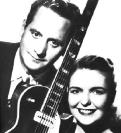
Les Paul and Mary Ford
| Amukiriki (The Lord Willing) | |||
| Hummingbird | |||
| I Really Don't Want to Know | |||
| I'm a Fool to Care | |||
| Magic Melody | |||
| Mandolino | |||
| |
Whither Thou Goest | ||
By 1952 Les Paul was not only the most popular guitar player in America, he was also a leading innovator in guitar and electronics design. He had been experimenting with electric guitars for as long as there had been electric guitars. He had once mounted a guitar string on a railroad tie to confirm his belief that a solidbody guitar would maximize sustain, and he had incorporated a mini-railroad rail-a 4"x4" piece of pine-into the body of a homemade solidbody electric guitar he nicknamed "TheLog." Les had approached Gibson in the '40s with his ideas for a solidbody electric guitar, but Gibson was already leading the industry with archtop electric guitars. Furthermore, Gibson had always been very conservative when it came to aligning with artists. In 50 years, only two players had their names on Gibson models: Nick Lucas, an early guitar star and crooner whose "Tip Toe Through the Tulips" was the biggest record of 1929, and Roy Smeck, a multi-instrumentalist so talented he was nicknamed "The Wizard of the Strings."
In the early '50s, when the solidbody guitar first became commercially viable, Gibson designed an instrument that would change the image of the solidbody electric from a simple plank of wood to an elegant, stylish piece of art. Such a guitar would be a radical move for a traditional company like Gibson, but Gibson had been founded on the radical mandolin and guitar designs of Orville Gibson back in the 1890s. This new model would have the same carved-top contours that had set Orville's instruments apart from all others.
With the new model almost ready for market, Gibson approached Les Paul, the obvious choice to help launch it. Les was already intimately familiar with the unique characteristics of a solidbody electric guitar. And he was at the top of his career. His 1948 hit, "Brazil," featured six guitar parts, all played by Les in a virtuoso demonstration that would eventually earn him recognition as the father of multi-track recording. When he combined his guitar and electronic talents with the vocals of his wife Mary Ford, the result was gold-two million-selling records in 1951, "Mockin' Bird Hill" and "How High the Moon."
The Les Paul Model, as it was originally called, has changed little since its debut in 1952. Except for an updated bridge and humbucking pickups, the Les Paul Standard of today is still the same guitar. The Les Paul has been the driving force behind many changes in popular music. It powered the blues rock sound of the late '60s and the southern rock of the late '70s. By the '90s the Les Paul was providing signature sounds for every genre of rock, from alternative to metal. In the late 1960s, Paul went into semi-retirement, although he did return to the studio occasionally. He and Mary Ford (born Iris Colleen Summers) had divorced amicably in December 1964, as she could no longer tolerate the itinerant lifestyle their act required of them. Paul's most recognisable recordings from then through the mid-1970s were an album for London Records, Les Paul Now (1967), on which he updated some of his earlier hits; and, backed by some of Nashville's celebrated studio musicians, a meld of jazz and country improvisation with fellow guitar virtuoso Chet Atkins, Chester and Lester (1977), for RCA Victor.
In 1978, Les Paul and Mary Ford were inducted into the Grammy Hall of Fame. He received a Grammy Trustees Award for his lifetime achievements in 1983. In 1988, Paul was inducted into the Rock and Roll Hall of Fame by Jeff Beck, who said, "I've copied more licks from Les Paul than I'd like to admit." Les Paul was inducted into the National Inventors Hall of Fame in May 2005 for his development of the solid-body electric guitar. In 2006, Paul was inducted into the National Broadcasters Hall of Fame. By the late 1980s, Paul had returned to active weekly live performances in New York City.
In 2006, at the age of 90, Les Paul won two Grammys at the 48th Annual Grammy Awards for his album Les Paul & Friends: American Made World Played. He also performs weekly, accompanied on piano by John Colianni, at the Iridium Jazz Club, on Broadway in New York City, despite the arthritis that has stilled all but two of the fingers on his left hand.